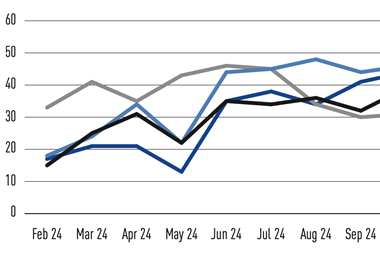In May the Chicago Mercantile Exchange (soon to be known as the CME Group following its merger with the Chicago Board of Trade) launched futures and options trading on the S&P/Case-Shiller Home Price Indices for 10 individual US cities as well as a composite index.
As of 7 November, there were 1,696 futures contracts outstanding, with a total open interest of $99.4m (€76m). There were 1,604 options contracts outstanding. While there are already covered warrants on home prices trading on the London Stock Exchange, and there are various commercial real estate products, there is no other futures market for individual homes anywhere in the world, nor has one ever succeeded before.
The new markets have appeared at a critical time in the US - and possibly the world - housing market, as a sudden weakness has appeared in those markets. Futures prices have deteriorated substantially since the markets were created. The abrupt change in the futures market prices is attracting attention to the fundamental hedging need that these markets can fill. The new markets therefore offer a really enormous new risk management vehicle.
There are signs that the new futures market is indeed stimulating the development of other risk-management products for home prices. In September, Goldman Sachs announced it would lead an initiative within the Wall Street broker-dealer community to create forwards, total return swaps, index swaps and index-linked notes tied to the S&P/Case-Shiller Home Price Indices.
The multiple-dealer working group has been co-ordinating its efforts with the International Swaps and Derivatives Association (ISDA) to develop documentation standards and settlement conventions. These products will be traded over-the-counter, and can be customised for clients in response to their specific needs. The launches of OTC housing products ought to complement and stimulate further the growth in the housing futures and options traded on the CME.
People are wondering if these products will really become a major hedging vehicle for real estate risks. The most common question that they ask is: these products sound like a good idea, but why have these derivative markets only just appeared? Why have prior attempts, such as the attempt at property futures at the London Futures and Options Exchange in 1991, failed? Why have the London spread-betting markets for home prices never amounted to much? Why have derivative markets associated with home prices been limited to ancillary markets such as mortgages, missing the entire primary housing market? In the US alone, the value of homes exceeds $22trn. How can such an enormous cash market have been overlooked by those who create derivative products? Or, is there a problem with the concept?
The answer to these questions, we believe, is that the concept is sound but that the home price indices have been slow to be perfected and gain credibility. One cannot settle a home price derivative contract by physical delivery. They have to be settled based on an index. And the major indices have not been up to the job, and widely accepted as such, until now.
It should not be surprising that index numbers of the necessary quality have not been available. While governments, trade associations and private firms produce thousands of indices, few of them are produced with any thought that they could be used in the settlement of contracts. As a result, the indices may be choppy through time, may not measure well an essential risk, may be subject to significant biases or revision magnitude after they are initially released, and may lack basic quality controls and safeguards against possible manipulations or leaks.
The producers of many of the home price indices that we read about in the news have had little incentive to bring them up to a standard demanded by global market makers, investors and risk managers. Most of the available data and indices serve other legitimate, but very different and less exacting, purposes - marketing is one common example.
Perhaps more significant, the producers of many indices are typically not experts on risk management or institutional investment. So, there is a vicious circle: little care to produce the indices suitable for exacting risk management and investment purposes because, to date, they have not been widely embraced for such use, and little used because little time and care has been devoted to creating indices that are trustworthy to settle large financial contracts.
Recognising this problem, in 1991 Karl Case, Allan Weiss and I founded Case Shiller Weiss (CSW), to produce home price indices expressly for the settlement of related financial contracts. We immediately campaigned, unsuccessfully at that time, to persuade an exchange to create futures or options markets based on the indices. I wrote journal articles about the construction of home price indices, and published a book about this: ‘Macro markets: creating institutions for managing society's largest economic risks', Oxford University Press, 19931.
The method that we developed in the early 1990s was a robust interval- and value-weighted arithmetic repeat-sales (Robust IVWARS) index, based exclusively on actual home sales (ie, no appraisal data), filtered to catch errors and non-arms-length or anomalous transaction data whenever possible. The interval- and value weighting of the sales had the effect of reducing the impact of noise in the price of individual homes and of making the index as representative as possible of the entire housing market.
The index was made arithmetic to eliminate a bias induced in an alternative (geometric) version of the method which we had originally developed (and called our weighted repeat sales or WRS method), and which had been adopted by others, including the Office of Federal Housing Enterprise Oversight (OFHEO) in the US. The index numbers produced via the Robust IVWARS Case-Shiller method are determined entirely by changes of prices between actual sales dates of the home (repeat sales), so that no biases are introduced by changes in the mix of sales on any given date. This is in contrast to other index number construction methods, such as the simple median of home sales. For example, the median price of a home sold may jump erratically at any time when a lot of large homes are sold, and plunge when a lot of small homes are sold2.
Given the enormous size of the residential real estate market (in the US, approximately 30% greater aggregate market value relative to the stock market) and the number and diversity of asset class stakeholders, the radical improvement in investment choices and risk management alternatives that will be enabled by such products will be of historic significance. When new derivative markets become liquid, they can contribute to transformed and better economies.
The price discovery facilitated within these new derivative markets should eventually make primary housing markets more efficient. This new paradigm for housing may help reduce the amplitude of the real estate cycle and the severity of economic booms and recessions3.
Robert Shiller is Stanley B Resor, professor of economics at Yale University, and co-author of the methodology underlying the S&P/Case-Shiller Home Price Indices
1The S&P/Case-Shiller Home Price Indices are now produced by Fiserv, Inc, under contract to our firm MacroMarkets LLC, headed by CEO Samuel Masucci, and with a partnership of Standard & Poor's and under the management of an index committee there headed by David Blitzer.
2For a full description of the method and procedures, see Standard & Poor's, S&P/Case-Shiller Home Price Index Methodology, June, 2006, http://www2.standardandpoors.com/spf/pdf/index/SP%20CS%20Home%20Prices%20Indices%20Methodology.pdf
3For further information about the indexes and markets, see http://housing.cme.com, or contact Terry Loebs, managing director, Property Derivatives, MacroMarkets LLC, tloebs@macromarkets.com.












No comments yet